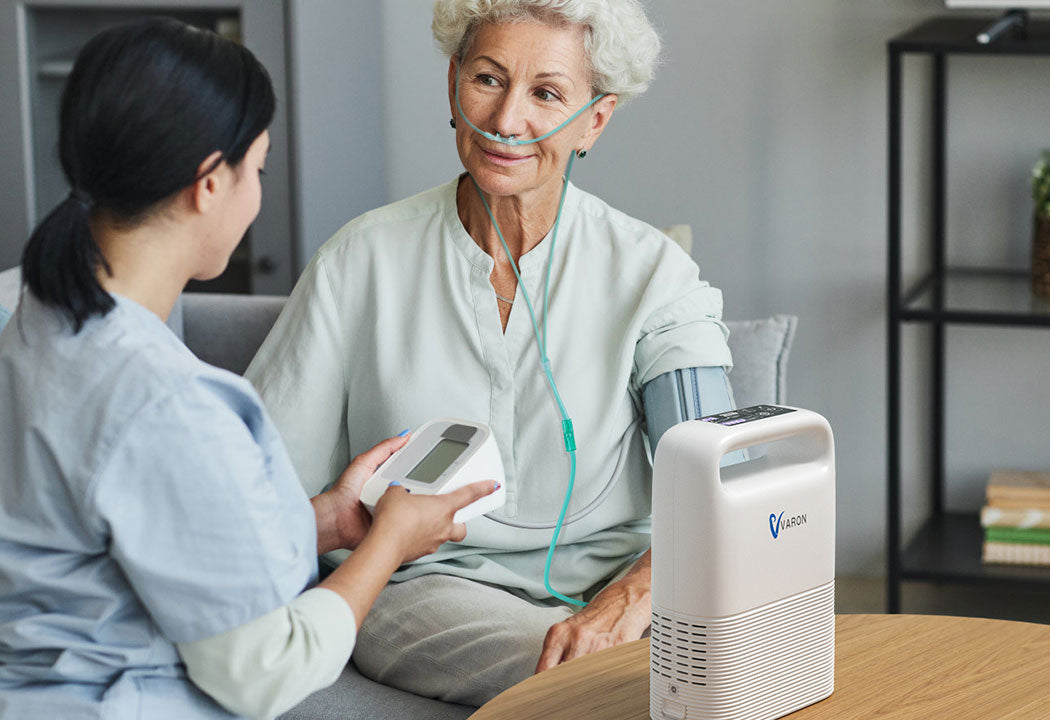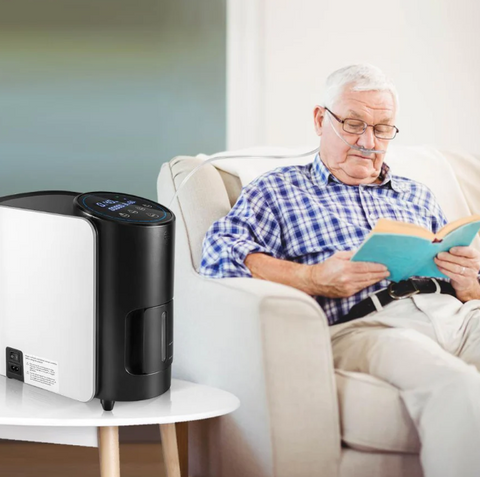
VARON: Your Trusted Partner in Senior Oxygen Therapy
What is an oxygen concentrator?

An oxygen concentrator is a health care device that filters oxygen from the surrounding air and delivers it to a patient in a concentrated form, typically through nasal cannulas. This non-invasive therapy eliminates the need for bulky and inconvenient oxygen tanks, significantly improving mobility and independence.
Imagine a device that pulls air from the room, like a miniature magician, and transforms it into a concentrated stream of pure oxygen, up to 95% strong. That's the magic of an oxygen concentrator, a medical marvel that revolutionizes the lives of individuals with respiratory difficulties.
How oxygen concentrator works
Unlike bulky oxygen tanks that store pre-compressed gas, concentrators are clever contraptions. They use a multi-step filtration process to sieve out nitrogen, the main component of air (about 78%), leaving behind the vital oxygen we need. This concentrated oxygen is then delivered directly to the patient through comfortable nasal cannulas, providing relief and improved breathing.
Why oxygen concentrator matter
For individuals with chronic respiratory conditions like COPD, sleep apnea, or heart failure, low oxygen levels can be debilitating. Traditional oxygen tanks, while effective, come with limitations. They're heavy, require constant refilling, and restrict mobility. Oxygen concentrators, on the other hand, offer several advantages:
- Non-invasive and comfortable: No needles or uncomfortable masks, just a gentle flow of oxygen through nasal prongs.
- Increased mobility and independence: No more lugging around heavy tanks, allowing patients to live a more active and fulfilling life.
- Continuous and reliable oxygen supply: No need to worry about running out of oxygen, providing peace of mind for both patients and caregivers.
- Cost-effective: While there's an initial investment, the long-term cost of using a concentrator can be lower than relying on refillable tanks.
Addressing a Growing Need
Chronic respiratory conditions, such as Chronic Obstructive Pulmonary Disease (COPD) and sleep apnea, are prevalent among the elderly population. These conditions can significantly impact daily activities, limiting mobility and enjoyment of life. Traditional oxygen therapy often involves bulky tanks and inconvenient refills, creating a burden for both patients and caregivers.

Why are oxygen concentrators beneficial for the elderly?
- Improved Quality of Life: Varon's oxygen concentrators for sale are lightweight, compact, and quiet, allowing seniors to participate in daily activities and social engagements without limitations. This can significantly enhance their quality of life and overall well-being.
- Increased Independence: Unlike traditional oxygen tanks that require frequent refills and limit movement, Varon's oxygen concentrators for sale offer continuous oxygen supply, empowering seniors to maintain their independence and live life on their own terms.
- Enhanced Safety: Varon's oxygen concentrators for sale feature built-in safety alarms and automatic shut-off mechanisms, ensuring maximum safety and peace of mind forboth seniors and their caregivers.
- Easy to Use and Maintain: Designed with user-friendly interfaces and intuitive controls, Varon's oxygen concentrators for sale are simple to operate even for seniors with limited technical knowledge. Additionally, their durable construction requires minimal maintenance, reducing reliance on external assistance.
VARON's commitment to the elderly
- Low Noise Operation: Varon's oxygen concentrators for sale operate at whisper-quiet levels, promoting restful sleep and undisturbed daily routines.
- Easy-to-Read Displays: Large, illuminated displays with clear instructions make monitoring oxygen levels and adjusting settings effortless.
- Portable Options: Varon offers home and portable oxygen concentrators for sale with optional battery packs, allowing for increased mobility and travel freedom.

Empowering Seniors through Innovation
As the demand for innovative healthcare solutions for seniors continues to rise, Varon remains committed to developing high-quality, user-friendly oxygen concentrators specifically designed for their needs. Our dedication to quiet operation, easy-to-use interfaces, and portability empowers seniors to regain their independence, improve their quality of life, and participate fully in daily activities.
5 FAQs About Oxygen Concentration for Senior Oxygen Therapy
1. What is the typical oxygen concentration used for senior oxygen therapy?
The typical oxygen concentration for senior oxygen therapy can vary depending on individual needs and underlying medical conditions. However, it usually falls within the range of 24% to 40%. This range is higher than the ambient air oxygen concentration (21%), but not high enough to be considered hyperbaric oxygen therapy (100% oxygen at increased pressure).
2. How is the appropriate oxygen concentration determined for a senior?
A healthcare professional, like a pulmonologist or respiratory therapist, determines the appropriate oxygen concentration for a senior based on a variety of factors. These factors include:
- Blood oxygen saturation (SpO2) measured by a pulse oximeter.
- Symptoms such as shortness of breath, fatigue, and confusion.
- Underlying medical conditions like chronic obstructive pulmonary disease (COPD), heart failure, and sleep apnea.
- Exercise tolerance and activity level.
Using an oxygen concentration higher than what is medically necessary can have several potential risks, including:
- Oxygen toxicity: This can cause damage to the lungs and other tissues, especially at concentrations exceeding 50% for extended periods.
- Increased risk of respiratory infections: High oxygen levels can make it difficult for the body to fight off bacteria and viruses.
- Dependency on oxygen: Long-term use of high oxygen concentrations can make it difficult for the body to utilize oxygen efficiently on its own.
It is important to be aware of signs that a senior might need their oxygen concentration adjusted. These signs include:
- Changes in SpO2 levels: If the SpO2 level falls below the target range consistently.
- Worsening symptoms: Increased shortness of breath, fatigue, confusion, or chest tightness.
- Headaches: This can be a sign of oxygen toxicity, especially at higher concentrations.
- Never adjust the oxygen concentration without consulting a healthcare professional.
- Monitor SpO2 levels regularly using a pulse oximeter as instructed.
- Keep the oxygen equipment clean and well-maintained according to the manufacturer's instructions.
It's important to remember that this information is not a substitute for professional medical advice. Always consult with a healthcare professional for any questions or concerns regarding senior oxygen therapy.
Take Control of Your Health Today
Visit our website to explore our wide range of oxygen concentrators for sale and discover the perfect solution for your needs. Our knowledgeable team is available to answer your questions and guide you through the selection process. Remember, you deserve to breathe freely and live life to the fullest. Let Varon be your partner on this journey.















اترك تعليقا